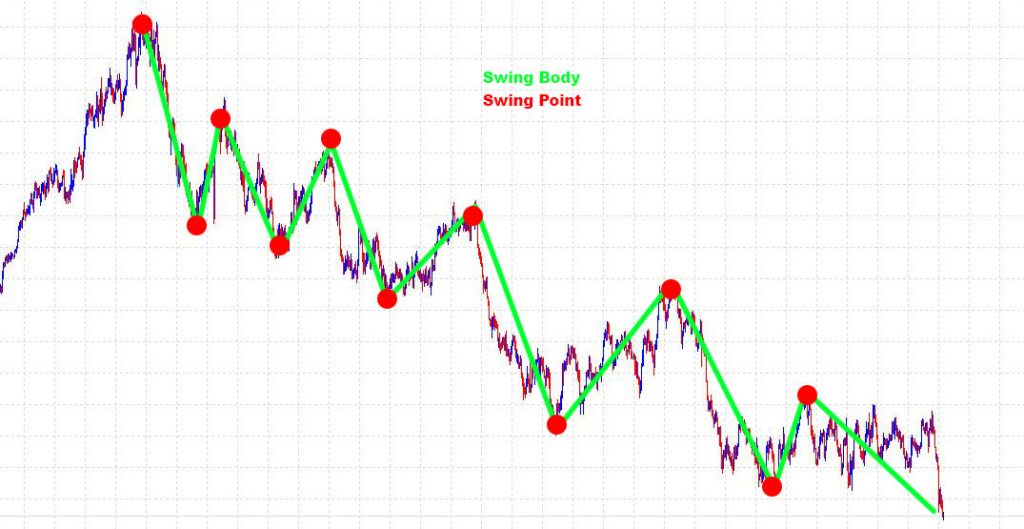How to Start Swing Trading the Forex Market
Finding a Forex trading strategy to get started can be a tough task to say the least. I mean, where do you even begin? How do you know if you’ve found one that’s right for you?
With thousands of different strategies out there, answering those two questions can be just as difficult. And, traders, it only gets worse when you factory in the countless different technical indicators out there.
But alas, that’s what we’re here for. The first step to solving these problems is to identify a trading style that suits you, such as swing trading. As a swing trader, as the name implies, traders attempt to profit from price swings in the market, which are in one of two stages – the body or the swing point as shown below.
As a swing trader, your aim is to time your trade entries in a way that allows you to catch the majority of each swing. With the gift of perfect hindsight, most newbies try to catch the extreme of each swing, but they soon realise that trying to pick tops and bottoms all too often results in more losses.
So, what do you do then? Well folks, just exercise some patience and wait for price action to confirm your buy or sell signal.
As discussed, swing traders try to catch large swings in the market, and as such this means that trades can last from a few days to a few weeks. Here’s how it’s done.
1 – First, switch to the daily chart. Swing traders don’t care for any of this short term scalping or day trading stuff. But why? Well, the daily timeframe paints a bigger picture of what’s happening to the instrument you’re trading, and as a general rule, price action signals tend to be much more reliable than on the shorter timeframes.
2 – Traders, this is the most important step that’ll transform you into a master swing trader tycoon. Draw your levels of key support and resistance areas. Think of support and resistance as the floor and the roof of your house, meaning, VERY IMPORTANT. Without these levels it’s impossible to identify solid swing setups.
So here’s what you do. Dray your horizontal support and resistance levels. Not only do these give you a simple method of determining swing points, but they offer some attractive target areas.
Next, draw your trendlines. Honestly, I swear by these because they help you determine the trend. But wait, there’s more! They also help a trader spot potential reversals before they actually occur.
3 – Take note of momentum. If you’re at this point, you’ve got your daily chart open and your levels & trendlines marked on the chart. Now, if you refer back to the picture above, you’ll notice that there are swing highs and swing lows clearly marked by the red dots.
What we’re looking to determine when we talk about momentum is the longer term force behind the market’s trend – up, down, or sideways. An uptrend will show a series of higher highs and higher lows. A downtrend will show a series of lower highs and lower lows. A sideways market looks messy and you can’t really determine an overall directional bias, but is bouncing in between what? That’s right, those horizontal support and resistance levels that you’ve already clearly marked on your daily chart.
4 – Now we’re getting to the fun part. When price approaches or reaches our support and resistance levels or trendlines we want to look for a candlestick pattern, and my two favs are the pin bar, and engulfing bar.
The goal here is to use these bars to buy or sell the market. You might not ever be able to catch the entire swing, but hey, that’s perfectly ok. The idea is to wait and confirm that price is moving according to your strategy.
5 – Next, we come up with some rules to outline how you’re going to exit these trades. As I always say, determining your stop loss level should always be done before you even think about your profit area. Why? Because this will help you determine your position size, and will also ensure that capital preservation is front of mind. Only once of you got your SL and TP values can you take the step of risking your capital. As soon as you enter a trade, you no longer have a neutral bias and that opens the door to emotional actions creeping in.
So how do you identify these stop loss and target areas? That’s right traders, we’re going back to those super-important horizontal support and resistance levels. Simply place your orders just underneath or above (depending on whether you’re long or short) these swing points and you’re set. Again, these support and resistance levels are the key to swing trading, so use them to your advantage.
That’s it folks… it really is simple. Wait, there’s one more thing. How do you know if swing trading is right for you?
Well, there’s no real right or wrong answer to this question. But if you don’t mind holding a trade for several days, or, you want more ‘you’ time and less time on the screens, or, you’re ok with taking less trades but potentially making more money on each trade, or, you’re working full time or studying, then swing trading is a pretty good solution for you.
Conversely, if you want some action-packed, fast-paced trading, or, can’t hold a position overnight, or, get anxious if a trade goes against you, then you might want to give swing trading a miss.
Ok, so now it’s up to you. Are you ready to get started swing trading the Forex market? Then now’s the perfect time to start practicing with a Vantage demo account. Just click here and you can starting honing your swing trading skills immediately.
Fast & easy account opening
-
Register
Choose an account type and submit your application
-
Fund
Fund your account using a wide range of funding methods.
-
Trade
Access 300+ CFD instruments across all asset classes on MT4 / MT5
That's it, it's that easy to open a Forex and CFD trading account.
Welcome to the world of trading!
open live account









